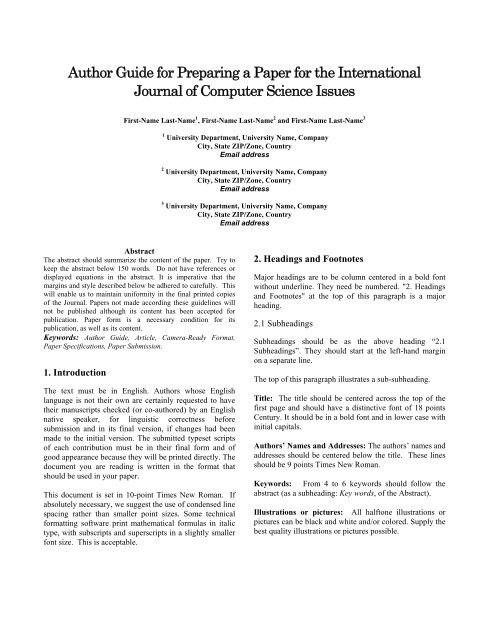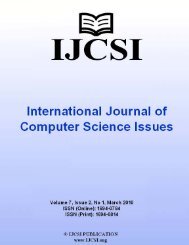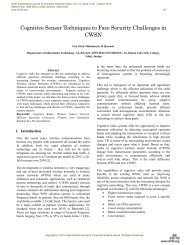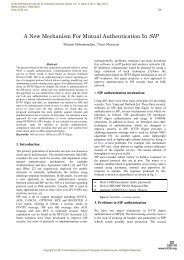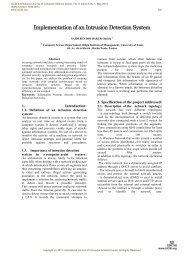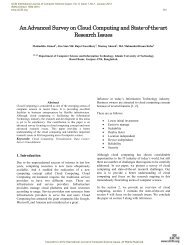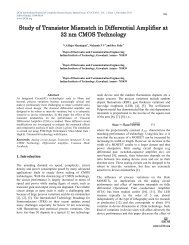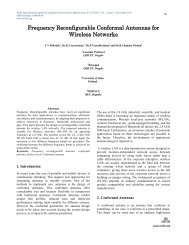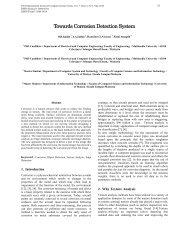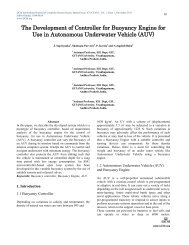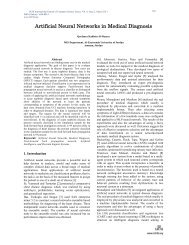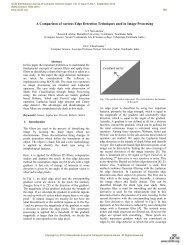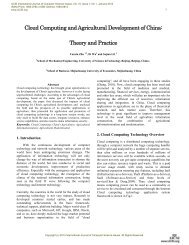PDF paper template - IJCSI
PDF paper template - IJCSI
PDF paper template - IJCSI
Create successful ePaper yourself
Turn your PDF publications into a flip-book with our unique Google optimized e-Paper software.
Author Guide for Preparing a Paper for the International<br />
Journal of Computer Science Issues<br />
First-Name Last-Name 1 , First-Name Last-Name 2 and First-Name Last-Name 3<br />
1 University Department, University Name, Company<br />
City, State ZIP/Zone, Country<br />
Email address<br />
2 University Department, University Name, Company<br />
City, State ZIP/Zone, Country<br />
Email address<br />
3 University Department, University Name, Company<br />
City, State ZIP/Zone, Country<br />
Email address<br />
Abstract<br />
The abstract should summarize the content of the <strong>paper</strong>. Try to<br />
keep the abstract below 150 words. Do not have references or<br />
displayed equations in the abstract. It is imperative that the<br />
margins and style described below be adhered to carefully. This<br />
will enable us to maintain uniformity in the final printed copies<br />
of the Journal. Papers not made according these guidelines will<br />
not be published although its content has been accepted for<br />
publication. Paper form is a necessary condition for its<br />
publication, as well as its content.<br />
Keywords: Author Guide, Article, Camera-Ready Format,<br />
Paper Specifications, Paper Submission.<br />
1. Introduction<br />
The text must be in English. Authors whose English<br />
language is not their own are certainly requested to have<br />
their manuscripts checked (or co-authored) by an English<br />
native speaker, for linguistic correctness before<br />
submission and in its final version, if changes had been<br />
made to the initial version. The submitted typeset scripts<br />
of each contribution must be in their final form and of<br />
good appearance because they will be printed directly. The<br />
document you are reading is written in the format that<br />
should be used in your <strong>paper</strong>.<br />
This document is set in 10-point Times New Roman. If<br />
absolutely necessary, we suggest the use of condensed line<br />
spacing rather than smaller point sizes. Some technical<br />
formatting software print mathematical formulas in italic<br />
type, with subscripts and superscripts in a slightly smaller<br />
font size. This is acceptable.<br />
2. Headings and Footnotes<br />
Major headings are to be column centered in a bold font<br />
without underline. They need be numbered. "2. Headings<br />
and Footnotes" at the top of this paragraph is a major<br />
heading.<br />
2.1 Subheadings<br />
Subheadings should be as the above heading “2.1<br />
Subheadings”. They should start at the left-hand margin<br />
on a separate line.<br />
The top of this paragraph illustrates a sub-subheading.<br />
Title: The title should be centered across the top of the<br />
first page and should have a distinctive font of 18 points<br />
Century. It should be in a bold font and in lower case with<br />
initial capitals.<br />
Authors’ Names and Addresses: The authors’ names and<br />
addresses should be centered below the title. These lines<br />
should be 9 points Times New Roman.<br />
Keywords: From 4 to 6 keywords should follow the<br />
abstract (as a subheading: Key words, of the Abstract).<br />
Illustrations or pictures: All halftone illustrations or<br />
pictures can be black and white and/or colored. Supply the<br />
best quality illustrations or pictures possible.
2.1 Footnotes<br />
Footnotes should be typed in singled-line spacing at the<br />
bottom of the page and column where it is cited.<br />
Footnotes should be rare.<br />
3. Tables, Figures and Equations<br />
3.1 Tables and Figures<br />
To insert “Tables” or “Figures”, please paste the data as<br />
stated below. All tables and figures must be given<br />
sequential numbers (1, 2, 3, etc.) and have a caption<br />
placed below the figure (“FigCaption”) or above the<br />
table(“FigTalbe”) being described, using 8pt font and<br />
please make use of the specified style “caption” from the<br />
drop-down menu of style categories<br />
arriving preset<br />
signals amplitude<br />
distribution<br />
array<br />
antenna<br />
Table 1: Margin specifications<br />
Margin A4 Paper US Letter Paper<br />
Left 18.5 mm 14.5 mm (0.58 in)<br />
Right 18mm 13 mm (0.51 in)<br />
MBF<br />
DIV<br />
DIV<br />
DIV<br />
3.2 Equations<br />
replica signal generators<br />
SQG<br />
r<br />
r 1<br />
2<br />
r p<br />
b 0<br />
b 1<br />
b m-1<br />
r 1 ・b 1<br />
*<br />
r 1 ・b 2<br />
*<br />
r 1 ・b m<br />
*<br />
DEL<br />
DEL<br />
LPF<br />
LPF<br />
LPF<br />
weight power threshold<br />
DEL<br />
beamformer 1<br />
beamformer 2<br />
beamformer p<br />
C-<br />
SEL<br />
Fig. 1 Proposed beam former.<br />
0 or 1<br />
replica/data<br />
timing<br />
× Control<br />
×<br />
× Control<br />
× Control<br />
×<br />
×<br />
+<br />
y 1<br />
y 2<br />
y p<br />
array output<br />
4. Conclusions<br />
The better your <strong>paper</strong> looks, the better the Journal looks.<br />
Thanks for your cooperation and contribution.<br />
Appendix<br />
Appendixes, if needed, appear before the acknowledgment.<br />
Acknowledgments<br />
Insert acknowledgment, if any. The preferred spelling of<br />
the word “acknowledgment” in American English is<br />
without an “e” after the “g.” Use the singular heading even<br />
if you have many acknowledgments. Avoid expressions<br />
such as “One of us (S.B.A.) would like to thank ... .”<br />
Instead, write “F. A. Author thanks ... .” Sponsor and<br />
financial support acknowledgments are also placed here.<br />
References<br />
[1] A. A. Name, and B. B. Name, Book Title, Place: Press, Year.<br />
[2] A. Name, and B. Name, "Journal Paper Title", Journal Name,<br />
Vol. X, No. X, Year, pp. xxx-xxx.<br />
[3] A. Name, "Dissertation Title", M.S.(or Ph.D.) thesis,<br />
Department, University, City, Country, Year.<br />
[4] A. A. Name, "Conference Paper Title", in Conference Name,<br />
Year, Vol. x, pp. xxx-xxx.<br />
First Author Biographies should be limited to one paragraph<br />
consisting of the following: sequentially ordered list of degrees,<br />
including years achieved; sequentially ordered places of employ<br />
concluding with current employment; association with any official<br />
journals or conferences; major professional and/or academic<br />
achievements, i.e., best <strong>paper</strong> awards, research grants, etc.; any<br />
publication information (number of <strong>paper</strong>s and titles of books<br />
published); current research interests; association with any<br />
professional associations. Do not specify email address here.<br />
Second Author biography appears here. Degrees achieved<br />
followed by current employment are listed, plus any major<br />
academic achievements. Do not specify email address here.<br />
Third Author is a member of the IEEE and the IEEE Computer<br />
Society. Do not specify email address here.<br />
They should be numbered consecutively throughout the<br />
text. Equation numbers should be enclosed in parentheses<br />
and flushed right. Equations should be referred to as Eq.<br />
(X) in the text where X is the equation number. In<br />
multiple-line equations, the number should be given on the<br />
last line.<br />
(1)


